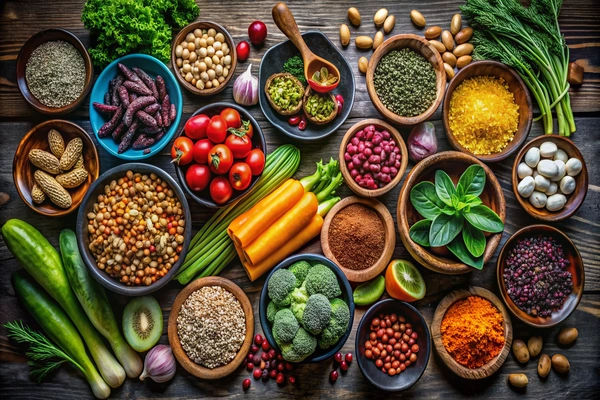Suji Ayurvedic Benefits, Uses, and Side Effects
Discover suji benefits, semolina nutrition, and Ayurvedic grains wisdom: uses, tips, and side effects. Learn who should avoid it and how to enjoy it smartly.

Written by Dr. M L Ezhilarasan
Reviewed by Dr. Dhankecha Mayank Dineshbhai MBBS
Last updated on 12th Nov, 2025

Introduction
Suji — also called rava or semolina — is a familiar ingredient in many Indian kitchens. Whether it’s used to prepare light upma for breakfast or a quick bowl of halwa, suji remains a versatile and comforting grain product. If you have ever wondered about suji benefits, semolina nutrition, or how it fits into the broader context of ayurvedic grains, this guide walks you through everything clearly and neutrally.
Suji is widely used because it cooks quickly, has a mild flavour, and blends easily with both sweet and savoury preparations. While it is not classified as a whole grain unless specifically labelled as whole durum (whole-wheat rava), it still has nutrition benefits when used sensibly — particularly when meals are balanced with vegetables, protein, and healthy fats.
This article breaks down:
- What suji (semolina/rava) really is
- Its nutritional elements and modern nutrition perspective
- Ayurvedic interpretation of how it should be used for comfortable digestion
- Who should be cautious due to wheat, gluten, or blood sugar concerns
- How to include suji in balanced everyday meals
Consult a Top Ayurveda Specialist for Personalised Advice
What is Suji (Rava) or Semolina?
Suji is the coarse, purified endosperm of durum wheat, a variety of wheat known for its firm structure and slightly higher protein content. It is processed into coarse granules, available in both refined and whole-wheat forms.
Suji is typically found in:
- Fine or coarse-grain textures
- Varieties used for savoury dishes like upma or sweet preparations such as halwa
Two important clarifications:
- Refined vs. whole-wheat rava
- Most packaged suji is refined, and during processing, the bran and germ are removed, reducing fibre content.
- Whole-wheat rava (sometimes labelled atta rava or whole durum) retains bran and offers more fibre and micronutrients.
- Not gluten-free
Since suji is made from wheat, it contains gluten and is unsuitable for:
- People with coeliac disease
- Individuals with wheat allergy
- Those with medically diagnosed gluten sensitivity
Suji Benefits at a Glance (Modern Nutrition View)
While traditionally part of Indian households, suji has a modern nutritional presence as a convenient ingredient that forms a quick base for balanced meals.
Potential advantages include:
Quick source of energy
Suji is rich in carbohydrates, which act as an accessible energy source.
Moderate protein
Durum wheat generally contains more protein than softer wheat varieties, helping support meal balance when paired with other protein sources.
B vitamins and iron
Depending on fortification policies and brand, semolina may include added B vitamins (e.g., thiamin, folate) and iron.
Versatile for healthy add-ins
Suji easily pairs with fibre-rich and protein-rich foods like vegetables, yoghurt, paneer, dal, nuts, and seeds.
Family-friendly texture
Its soft, porridge-like consistency makes recipes beginner-friendly and suitable for all age groups.
Semolina Nutrition: Key Facts
Actual nutrition varies by brand and whether suji is refined or whole grain. As a general guide (per 100 g dry refined semolina):
- Calories: approx. 360 kcal
- Carbohydrates: approx. 70–75 g
- Protein: approx. 12–13 g
- Fat: approx. 1 g
- Fibre: approx. 2–4 g (higher in whole-wheat rava)
Micronutrients may include:
- Iron
- B vitamins (depending on enrichment/fortification policies)
For more specific breakdowns, check your package or food database listings.
Ayurvedic Grains Perspective: Where Does Suji Fit?
Ayurveda does not classify suji as a “superfood,” but it integrates well into meals when prepared thoughtfully.
Ayurveda values:
- Warm, freshly cooked meals
- Soft, digestible textures
- Balanced flavours using digestive spices
Although modern scientific literature has focused exclusively on the ayurvedic benefits of suji is limited, traditional cooking techniques overlap strongly with what we now recognise as healthy eating.
Ayurvedic preparation techniques
Cook until soft and warm
Warm meals are believed to support digestive comfort in Ayurveda.
Include digestive spices
- Cumin, mustard seeds, ginger, black pepper, curry leaves, and hing (asafoetida) are commonly used in Indian kitchens.
- These ingredients add flavour and may support more comfortable digestion.
Balance the plate
Include vegetables, healthy fats, and protein sources (dal, tofu, paneer, eggs, yoghurt, nuts).
Choose whole grains when possible
Whole-wheat rava (higher fibre) aligns better with ayurvedic and nutrition recommendations.
Who Should Be Cautious: Side Effects and Risks
The side effects and risks include:
Coeliac disease and gluten intolerance
Suji contains gluten. It should be completely avoided by:
- Individuals diagnosed with coeliac disease
- Those with medically identified gluten sensitivity
- People with confirmed wheat allergies
Diabetes and blood sugar concerns
- Refined semolina has lower fibre and may cause quicker glucose spikes.
- Whole-wheat rava or adding vegetables, protein, and healthy fats can slow digestion and steady blood sugar.
Digestive sensitivity (IBS, FODMAP concerns)
- Wheat contains fructans (a type of FODMAP).
- Individuals with IBS may experience gas or bloating.
- A clinician-guided FODMAP approach may help identify triggers.
Low fibre (if refined suji is overused)
Diets high in refined grains and low in fibre can impact:
- Bowel regularity
- Heart and metabolic well-being
Weight management
- Suji is calorie-dense for a small volume.
- Balanced plating and portion awareness help maintain goals.
How to Use Suji in a Healthy, Everyday Way?
Ideas to use suji in everyday foods are:
Choose the right type
- Prefer whole-wheat rava when available.
- If using refined suji, ensure meals include vegetables or legumes.
Watch the portions
A common measure is approximately ¼–⅓ cup of dry suji per person (for a main dish).
Build balanced meals
- Add vegetables: carrots, peas, spinach, tomatoes, onions
- Add protein: dal, chickpeas, tofu, paneer, eggs, yoghurt
- Add healthy fats: a modest amount of oil or ghee
Enhance flavour with digestive spices
- Cumin
- Mustard seeds
- Curry leaves
- Ginger
- Black pepper
- Hing (if tolerated)
Mind sweetness in desserts
- Keep sugar modest
- Add nuts, seeds, or fruit for texture and nutrition
Quick, Healthier Suji Meal Ideas
Quick & tasty meal ideas are:
Vegetable upma with peas and peanuts
- Dry roast suji.
- Sauté vegetables and digestive spices.
- Add water, salt, and suji; cook until fluffy.
- Finish with lemon juice and peanuts.
Savoury suji pancakes (uttapam-style)
- Prepare batter using yoghurt and water.
- Add chopped vegetables.
- Cook on a pan and serve with chutney or sambar.
Creamy breakfast porridge
- Cook suji with milk or fortified plant milk.
- Flavour with cinnamon or cardamom.
- Garnish with nuts, seeds, or a few berries.
Protein-packed suji bowl
- Use suji like a soft grain base.
- Top with cooked vegetables and chickpeas/eggs/tofu.
Whole-wheat rava pilaf
- Prepare like upma.
- Add extra vegetables, chickpeas, and herbs.
Semolina Nutrition Tips for Special Situations
The nutrition tips for special consideration are:
For active lifestyles
- Suji gives readily available carbohydrates.
- Pair with protein and vegetables for better recovery and satiety.
For heart and metabolic health
- Choose whole grains more often.
- If using refined suji, include fibre-rich sides.
For sensitive digestion
- Keep portions moderate.
- Cook suji thoroughly and use gentle spices.
Conclusion
Suji can be a nutritious and versatile ingredient when included as part of a balanced eating routine. Its neutral flavour and soft, comforting texture make it suitable for a variety of dishes, ranging from breakfast porridges to savoury meals. While refined suji is convenient, choosing whole-wheat rava and pairing it with vegetables and protein significantly enhances nutritional value. Individuals with gluten intolerance or specific metabolic concerns should stay cautious and seek personalised advice. Ultimately, suji can support mindful eating when used with intention, balance, and moderation.
Consult a Top Ayurveda Specialist for Personalised Advice
Key Takeaways
- Suji is a versatile ingredient that fits into balanced eating patterns.
- Whole-wheat rava is a better choice for higher fibre.
- People with coeliac disease or wheat intolerance should avoid suji.
- Balanced plating helps manage blood sugar and weight.
- Ayurvedic-style preparation focuses on warmth, soft texture, and mindful use of spices.
Consult a Top Ayurveda Specialist for Personalised Advice

Ms. Samapti Maity
Dietician
11 Years • Bsc (Clinical Nutrition & Dietitics), NDEP, Course in Maternal Infant Young Child Nutrition.
Kolkata
BIENETRE CLINIC, Kolkata

Dr. Anupriya C
General Physician/ Internal Medicine Specialist
5 Years • MBBS, MD, General Medicine
Bengaluru
Apollo Clinic, JP nagar, Bengaluru
Dr Sumanth R
General Physician
2 Years • MBBS
Bengaluru
PRESTIGE SHANTHINIKETAN - SOCIETY CLINIC, Bengaluru

Neelanjana J
clinical nutrition
3 Years • Bsc., Msc. Nutrition and Dietetics.
Bengaluru
Apollo Clinic, JP nagar, Bengaluru

Ms. Soma Saha
clinical nutrition
17 Years • B.Sc. - Home Science (Food & Nutrition), M.Sc. - Home Science (Food & Nutrition)
Kolkata
Dr Utsa Basu Clinic, Kolkata
(50+ Patients)
Consult a Top Ayurveda Specialist for Personalised Advice

Ms. Samapti Maity
Dietician
11 Years • Bsc (Clinical Nutrition & Dietitics), NDEP, Course in Maternal Infant Young Child Nutrition.
Kolkata
BIENETRE CLINIC, Kolkata

Dr. Anupriya C
General Physician/ Internal Medicine Specialist
5 Years • MBBS, MD, General Medicine
Bengaluru
Apollo Clinic, JP nagar, Bengaluru
Dr Sumanth R
General Physician
2 Years • MBBS
Bengaluru
PRESTIGE SHANTHINIKETAN - SOCIETY CLINIC, Bengaluru

Neelanjana J
clinical nutrition
3 Years • Bsc., Msc. Nutrition and Dietetics.
Bengaluru
Apollo Clinic, JP nagar, Bengaluru

Ms. Soma Saha
clinical nutrition
17 Years • B.Sc. - Home Science (Food & Nutrition), M.Sc. - Home Science (Food & Nutrition)
Kolkata
Dr Utsa Basu Clinic, Kolkata
(50+ Patients)
More articles from General Medical Consultation
Frequently Asked Questions
Is suji good for weight loss?
Yes — provided that portions are controlled and the dish is balanced with vegetables, protein, and healthy fats.
Is suji gluten-free?
No. Suji contains gluten and should be avoided by people with coeliac disease, gluten sensitivity, or wheat allergies.
Is semolina good for diabetics?
It depends on portion control, preparation, and the overall meal composition.
What’s the difference between suji, rava, semolina, and dalia?
The difference between them is
Suji/rava/semolina refer to the same ingredient derived from durum wheat. Dalia is typically cracked whole wheat, offering higher fibre.
Are there science-backed ayurvedic benefits of suji? A
Modern clinical research on ayurvedic benefits of suji is limited, but ayurvedic meal preparation techniques encourage digestion-friendly cooking.




